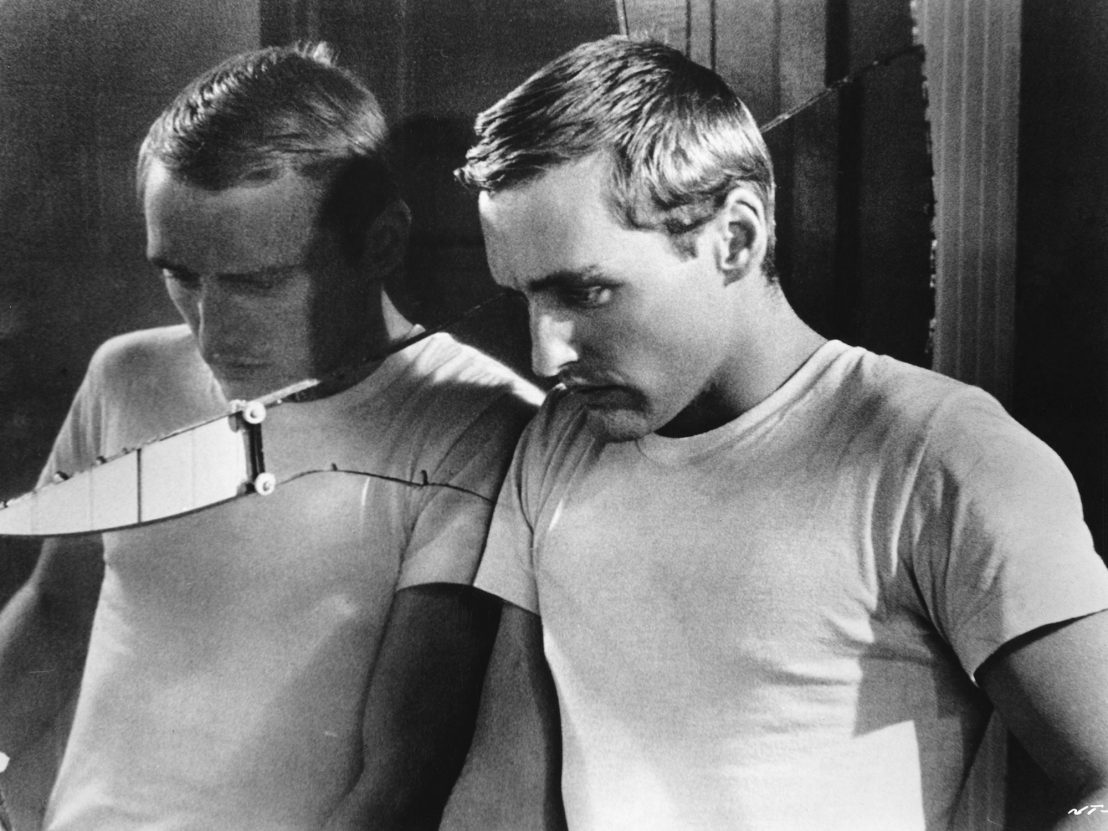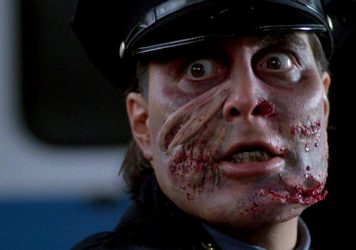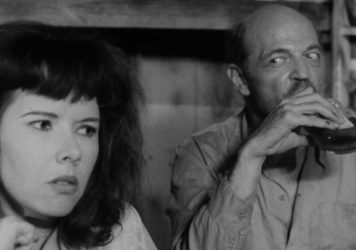
The director’s ongoing restoration project, byNWR, is breathing new life into forgotten cult movies.
Since its launch in 2018, byNWR has screened for free, on the purpose built site and in partnership with MUBI, some of the strangest and most unique films ever made to no discernible critical response.
At its heart, this “unadulterated cultural freeway” (as Nicolas Winding Refn describes it) is an archive and restoration project aimed at inspiring future generations of cineastes. The films that have been bought from libraries, collected and painstakingly restored run the gamut from fetish through cult, punk and propaganda to blaxploitation, covering everything in between.
Take for example Jac Zacha’s 1970 drama Walk the Walk, starring Bernie Hamilton as a heroin addict and theology student named Mike. The look, music and story – Mike gets in hock to drug-dealing entrepreneur Judy, who is constantly tempting him into bed and back on to the demon dope – makes the film feel like an early blaxploitation outlier, but it never veers into easy exploitation, resisting overt sexualisation and violence in favour of something far more personal and soul-searching.
ByNWR’s collection is presented in thematic chapters, each containing three films, with titles such as ‘Hillbillies, Hustlers and Fallen Idols’, ‘Smell of Female’ and ‘You Ain’t No Punk, You Punk’. Each chapter also comprises a vast collection of original writing, video and photographic archive material, live performance and other ephemera, both on the films and filmmakers contained within and also on myriad avenues of contextual interest that spring from the movies. It’s criminal that more isn’t being written about these films, presumably because the project is regarded as a benevolent folly.
Since its inception, byNWR has mostly operated in the shadows. However, 2020 sees the platform stretch out into the light a little more. There is a book on cult director Andy Milligan titled ‘The Ghastly One’, written by the site’s editor-in-chief Jimmy McDonough. There’s the continued use of the brand to signal Refn’s forays into the space between cinema and television: 2019’s Too Old to Die Young and the upcoming Maniac Cop series.
First up though, they’ve partnered with Indicator/Powerhouse for a special release of one of the key films from the collection, Curtis Harrington’s Night Tide. We caught up with Refn to chat about the philosophy of byNWR, how spending so much time in these odd, beautiful worlds may have rubbed off on his own filmmaking, and the hidden gems he thinks everyone should check out.
LWLies: How did you start collecting these films?
Refn: Pure accident; an acquaintance introduced me to a company in the US that was selling their inventory. It was called Something Weird and they’d been collecting and distributing obscure films in the US for 30 years. They specialised in public domain titles and I was able to get their inventory list. I gave it to Jimmy McDonough who put a red dot next to all the things that we should try to get. I have collector-mania. I’ve collected many things and I like the archival hunt for obscurities, especially if they’re cultural artefacts. Some of these movies, and I’d never seen most of them, had great titles, and felt like cultural artefacts of an era.
Night Tide was a film that I was personally very fond of as I knew the director, Curtis Harrington, a little bit before he passed away. I find that movie to be quite unique, so that was my own personal obsession. Peter [Conheim, byNWR archivist and head of restorations] introduced me to Spring Night, Summer Night, which I didn’t end up buying at that time. We were lucky to get the entire Radley Metzger library. Sometimes we’ve been able to buy entire libraries of certain filmmakers or distributors. Other times it’s been piecemeal, things have been given, found. I leave it to Peter to sift through the cracks, but I like the hunt.
Why does it matter to you that these films are available for people to see, properly curated and written about so deeply?
We curate culture. If you want to see a movie on YouTube, there’s millions of them. For us, it was about ‘what are cultural artefacts of significance that maybe haven’t been given the time of day, or potentially the proper respect, or been seen in a different light?’ Most of the films that are in the collection are very extreme cinema and there’s something for every kind of fetish taste. Nowadays, when culture is getting so neutralised and mundane it’s important that we remember that cinema can still be an extreme language. And the more extreme it is the more interesting it becomes.
Do you see your role as being the figurehead for drawing an audience in to see this stuff, using your profile?
I owned a company [that could form the basis of the business], so there’s that part of it. But, for me, it’s not so much about the movies themselves, it’s more about the idea that culture can be so many different things and we have a tendency to forget that. Part of the concept of byNWR was to create an online museum, that celebrated the past. A digital domain that’s endless, because when you have physical barriers there’s always the limitation of the physical barriers, whereas here it’s limitless. It needed to be accessible to everyone – every month had to be free, because culture is everyone’s domain. And by not charging for it we also surpass all the norms, because what we’re doing, generally no one else can do or does.
Also, the initial philosophy of byNWR was that we would go past all the ideas of what is considered great, correct, taste, or good or bad. A lot of our work up until now has been very focused on the films themselves and we’re starting now on the next phase of the philosophy by moving into different arenas. But, in terms of the films, we forget that films are actually more interesting the more personal they are. And the more personal they are, the more they rise past good or bad, you know, a rotten tomatoes score. We want to inspire young people by getting them to always remember that film, like any art form is a personal projection from the creator to the experiencer.
You’ve been going for over a year now, has the response to the site been what you hoped it would be?
That’s a very interesting question, because once we started we realised it was like a moving train that can’t really stop unless it implodes. When you begin, you make your share of mistakes, but to be frank, it’s surprising how well it’s going. It’s very rewarding every week when we go through our weekly reports and see that things have just continued to escalate, in a very organic way. We don’t promote, we don’t buy advertising. We’re not an institution that needs to gain something in the end, other than to inspire. We’re a discovery process.
One of the most thrilling moments was seeing the Ed Wood-scripted Orgy of the Dead pop up.
What a fantastic experience! It’s a very, very peculiar movie. It’s almost like an art installation to me. It’s not a movie. It’s more like an experience, right?
Yes, those repetitious sequences of dancing, hypnotically strung together. It is just really exciting to have experiences like this presented with such a loving approach. Some of the humanity and emotional complexity in these films is astounding.
Night Tide is an absolute masterpiece in my opinion and, incredibly, one of the few films that actually was able to bring a fairy tale naturally on to the screen. I think Maidens of Fetish Street is obviously a very personal film, and, my god, whoever made it is so tormented.
There are so many creative innovations and amazing artistic flourishes caused by the production limitations these filmmakers faced.
Limitations are far more rewarding artistically than just having everything at your disposal. Everything at your disposal also means a lot of people’s opinions have to be heard, dealt with, or abided by.
These filmmakers find a lot of space to express themselves.
They were filmmakers that had one vision and that was their own. The Nest of the Cuckoo Birds I found to be one the most amazing films I’ve ever seen. Is it good or bad? It’s beyond that, in my opinion.
You’ve mentioned a few titles in our conversation, but what are your personal favourites to have come out of this project so far?
The things that I really enjoyed were, of course, Night Tide. I think Spring Night, Summer Night is a fantastic film. Maidens of Fetish Street I have a very personal fondness for because it’s so extreme. It has this very peculiar voiceover narrator. I love the pulpiness and almost installation sensibility of Orgy of the Dead. Olga’s House of Shame I find fascinating. Joseph P Mawra who made that film was a very interesting filmmaker.
But, overall, probably The Nest of the Cuckoo Birds and Night Tide, for me, are the most treasured trophies so far. We have so many things coming down the pipeline but they really resonated. I think there was a reason why we started with Nest of the Cuckoo Birds as our first film, in Jimmy’s first programme. That was chosen because it set the standard for the frontier that we wanted to push.
Night Tide is out now on limited edition Blu-ray via Indicator/Powerhouse.
Published 27 Jan 2020

The Neon Demon director is working on a new update of William Lustig’s cult classic from 1988.

With The Neon Demon the Danish writer/director has made his most provocative film yet. We travelled to Copenhagen to meet him.

We’ve teamed up with the director of Drive and The Neon Demon to bring weird cinema to the masses.